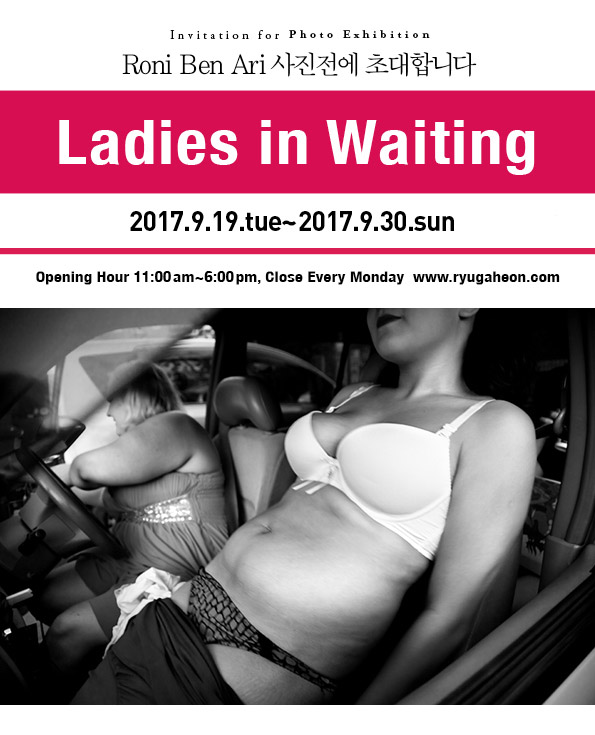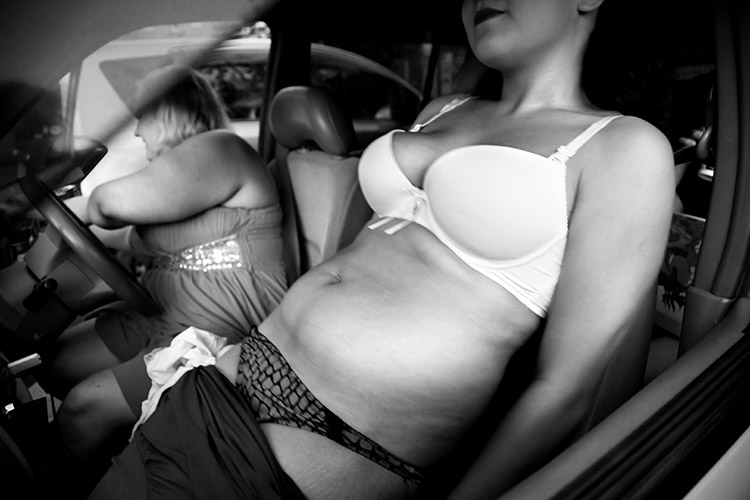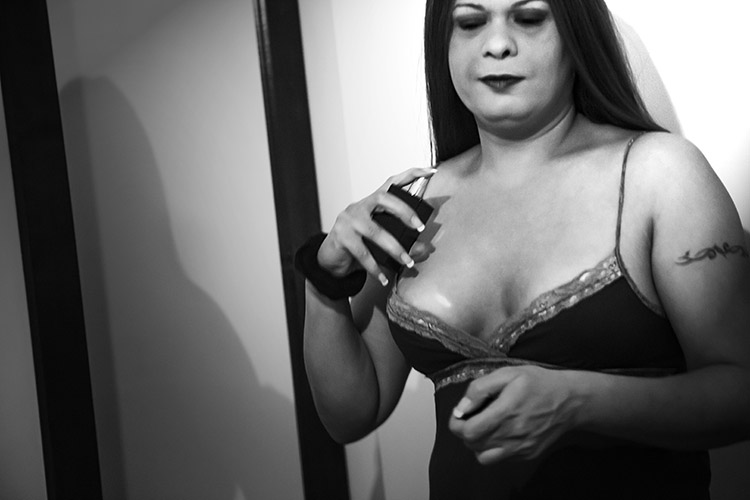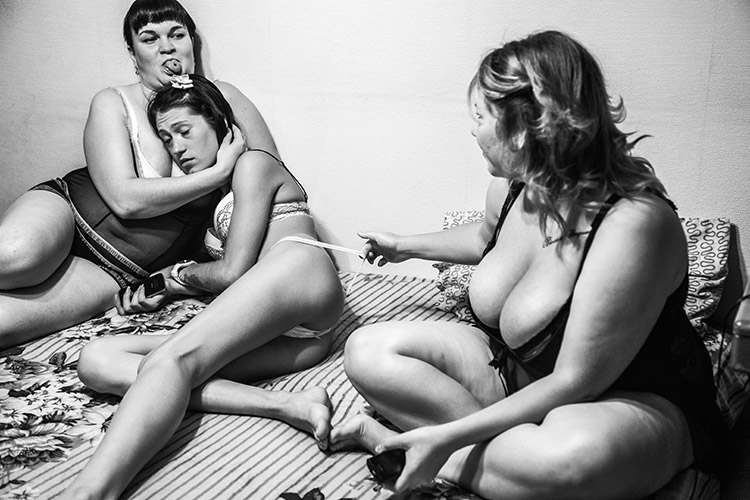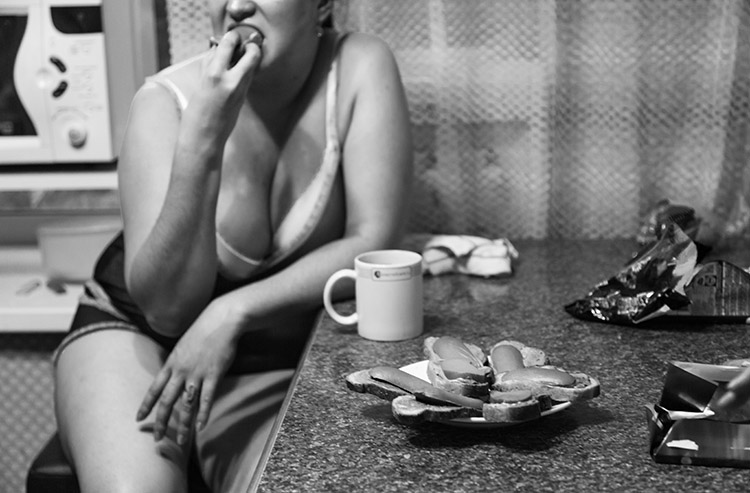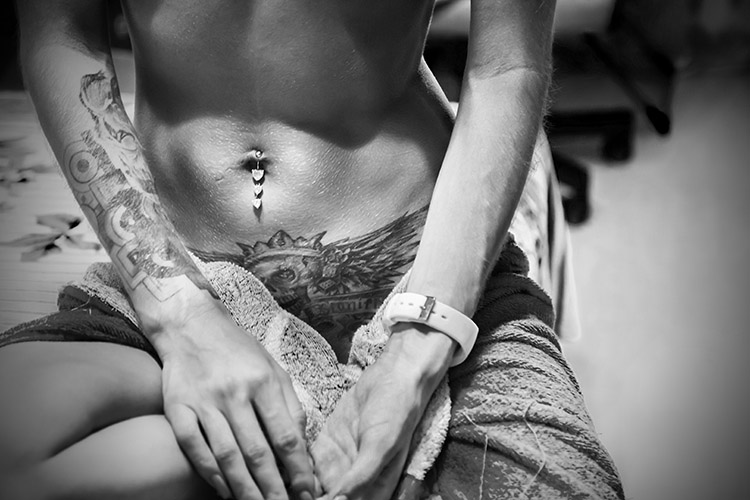Ladies in Waiting
During the years with multi-media art work I documented social issues, bringing to the surface social subjects of traditional marginal groups who are invisible to mainstream
society: the elderly, the homeless, the gypsies, the Ethiopians, Ecology and various minority sectors etc.
UNESCO has recently chosen to present my work as an excellent example of an artist who raises awareness of the connection between Art & Society.
These pictures are part of a photography project documenting prostitution in a number of countries. For a year and a half
I have photographed in Israel, India, Russia and Nederland. The photographs displayed here are classic examples of social photography reflecting society’s margins. My photography continues a tradition of documentary activity that aims to shed light on those individuals we would rather not see:
the rejected, the invisible, and the voiceless.
In my capacity as a Photographer I have chosen this time to address the subject of prostitution.
I became interested in this issue as a result of my volunteer work with a mobile health clinic in Tel Aviv (Israel) which offers medical care and food to women who work as prostitutes, either on the streets or inside apartments.
The staff of the mobile clinic includes a doctor, a nurse, a social worker and volunteers who travel on scheduled days to the places where the prostitutes work and offer them blood and aids testing, and distribute condoms and needles, as well as sandwiches and hot drinks, in order to build their trust and provide them with a welcoming and caring environment where they can speak out and find a listening ear and warm hug.
While I was fulfilling my volunteer duties and during the small talking, I introduced myself to each of the prostitute, separately, that I am a photographer who is doing a photography project on their daily life. I asked if it is possible to make a meeting in a comfortable place without camera! only to drink a cup of coffee or a meal together for talking and explanation to my wish. This process took time to build the trust. I never shoot a photo without permission. Everything was done in will and consent. When trust was created, the door to rooms in which they worked was opened for me.
In other countries, my contact was made through a small non-profit organization, one administered by a group of women who had served time in prisons for murder and drug-dealing, and after their release decided to give back to society. They provide aids testing for prostitutes working outside on the streets and inside apartments and also distribute condoms and lubricants, all paid for with the donations which they collect for the purpose of bettering the health of the sex worker.
As opposed to the street sex worker that takes place outside, in cars and backyards most apartments are located in neighborhood apartment buildings. There are no visible outward signs of what takes place behind the closed front door of the apartment in which prostitutes live and work. In between customers, they go about normal daily routines, eating together, talking, laughing and having fun. Even though I could, I had no interest in photographing the sex acts that went on behind the closed doors. My aim was to position the camera as a mirror to capture what went on in the time in-between customers. In this way, it was possible to see the women as human beings beyond the use of their bodies.
‘기다림의 틈새’에서 드러나는 일상, 그리고 존재
- Roni Ben Ari 사진전 [Ladies in Waiting] 9월 19일부터 류가헌에서
누군가를 기다리는 여성들.... 그녀들은 ‘있다’. 세상 곳곳에. 공식적으로 알려진 숫자만 독일에 40만 명, 이탈리아 5만 명, 네덜란드 1만 5천명 그리고 대한민국에 27만 명.... 성매매 여성들의 숫자다. 이렇게 많은 수의 여성들이 우리와 동시대의 삶을 함께 살아가고 있지만, 그녀들은 보이지 않는다. 보이지 않는 것이 아니라 ‘없다’. 존재 자체를 부정 당한다. 분명한 실체이지만, 사진적 기록조차 쉬이 허락되지 않는다.
그런 속에서 이스라엘 사진가 Roni Ben Ari(로니 벤 아리)가 한국에 처음으로 선보이는 [Ladies in Waiting]은 여러 가지 관점에서 우리에게 퍽이나 낯선 사진들이다. 부분적으로 신체만 드러나 있든 얼굴과 몸짓, 어떤 상황들이 드러나 있든 사진 속의 여성(Prostitute)들은 한결같이 자연스럽다. 이 사진들 속 공간의 일부를 과연 사진가와 카메라가 점유했었는지 믿기지 않을 정도다.
이스라엘에서 러시아, 네덜란드, 인도... 수많은 성매매 현장을 눈앞에 두고 있었으나, Roni Ben Ari가 주목한 것은 특별한 수식이 필요 없는 그녀들의 단순한 ‘일상’이었다. [Ladies in Waiting(‘시중드는 여성’이라는 의미를 함께 가지고 있다)]이라는 제목처럼 작가는 ‘손님을 기다리는’ 중인 성매매여성들을 찍었다. 사진의 지리적 배경은 다양하지만, 흐르는 풍경은 일관된다. 사진 속 여성들은 식사를 하고, 드라이기로 머리를 말리고, 입을 옷을 고른다. 강아지와 놀아주기도 하고, 동료들과 함께 웃고 떠들거나 장난친다. 다만 그 일상은 모두 ‘손님을 보내고’ 다시 새로운 ‘손님을 맞으러’ 기다리는 틈새의 일상이다.
“그녀들은 어디에나 있어요. 그러나 그녀들은 어디에도 존재하지 않지요. 저는 제 사진으로, 그녀들이 존재한다는 사실을, 때론 웃고, 때론 울며 살아가는 우리들처럼 그녀들도 그렇게 함께 우리와 같은 시대를 살아가는 존재들이라는 것을 말하고 싶었습니다.”
1947년 이스라엘에서 태어난 Roni Ben Ari는 60년대와 80년대를 TV 등 방송매체의 연구원, 기자로 보냈고, 96년부터 사진가로서 활동을 시작해 현재 이스라엘의 대표적인 여성 사진가로서 자리매김을 했다. 그녀의 작업 방식은 이민자, 집시, 노인 등 사람이 중심이 되는 사회적 이슈들에 대해 긴 시간 연구하는 것을 특징으로 한다. 그 결과 ‘카메라와 함께, 그는 그들의 존재 자체를 무시하는 고상한 사회에 대한 거울로서 그들의 일상과 인간성을 표현한다’라는 평을 얻고 있으며, 저널리즘적인 에세이로 구성된 그녀의 사진들은 정부, NGO, 개인적인 결단력들이 약한 이들을 보호할 수 있는 법을 확장하고 그들을 지원하기 위한 행동을 촉구하는 역할을 해왔다.
[Ladies in Waiting]는 2015년부터 최근까지 모국인 이스라엘부터 러시아, 네덜란드, 인도등 여러 나라의 성매매 현장을 찾아다니며 기록한 사진들이다. 오랜 시간 성매매 여성들을 ‘다른 사람’으로 구분지어 온 사회에서, 색다를 것 없는 이들의 일상 속 장면들은 오히려 낯선 역설의 방식으로 주제의 특수성을 부각시킨다.
Roni Ben Ari의 사진전[Ladies in Waiting]는 9월 19일부터 30일까지 2주 동안 갤러리 류가헌에서 이어진다.
* Roni Ben Ari는 2017 제16회 동강국제사진제 국제공모전에 선정된 올해의 작가 중 한 명이다.
The presence and daily life revealed in “waiting”
- Photo exhibition [Ladies in Waiting] from September 19 in Gallery Ryugaheon
Women waiting for someone. They ‘exist’ in many places in the world. 400,000 in Germany, 50,000 in Italy, 15,000 in the Netherlands and 270,000 in South Korea. These are officially recorded number of prostitutes. A number of them live together in life with us, but they are invisible. They are denied their ‘presences’. Even though they are clear entities, no photographs are allowed to be taken lightly.
With this background, [Ladies in Waiting] that is first released in Korea of Israel photographer Roni Ben Ari is unfamiliar in many perspective. Prostitutes in the picture are natural, whether they are partially exposed to the body, body movements, or any situation. It’s hard to believe that there were the photographer and camera.
Israel, Russia, the Netherlands, India... Although there had been countless scenes of prostitution, what Roni Ben Ari focused on was normal ‘daily life’ of prostitutes. Like the title [Ladies in Waiting], she captured ladies who ‘waited’ for the customers. Women in the photographs eat their meals, dry their hair, and choose clothes to wear. They also play with dog, and laugh, chat or play together. All the daily routines are between customers.
“They are everywhere. But they don't exist anywhere. And I wanted to tell you that, in my pictures, that they existed and they spend the same time in the same space as ours, and live a life that is not significantly different from us.”
Born in 1947, Roni Ben Ari, who was born in Israel, sent the 1960s and 80s to study as a researcher, and began her career as a photographer since 1996. Her works are characterized by long term studies on social issues such as immigrants, gypsies, and the elder. With her camera she present their daily lives and humanity as a mirror to the cultured world that ignores their very existence. Many projects she exhibit all over the world shine a spotlight on the society living in the shadows, with the photographs serving as a kind of journalistic essay, the role of which is to prod government bodies, NGOs, and private initiatives into action to expand the laws protecting the weak and enforce them.
[Ladies in Waiting] is the work that has been recorded prostitutes from various countries such as Israel, the Netherlands, Russia and India since 2015. In a society that has been separated them as different group for a long time, the daily scenes of prostitutes, paradoxically, tend to look strange and emphasize the uniqueness of them.
Roni Ben Ari's Photo Exhibition [Ladin in Waiting] runs from September 19 to 30 in Galler Ryugaheon for two weeks.
Ladies in Waiting
멀티미디어 예술작업을 하는 동안, 주류에서 보이지 않는 전통적인 비주류의 삶들을 표면으로 끌어내며 다양한 사회적 이슈를 기록했다.
사회: 노인, 노숙자, 집시, 에티오피아인, 생태 그리고 다양한 소수자들 등등
유네스코는 최근 내 작업을 예술과 사회의 통섭의 중요성에 대한 인식을 불러일으키는 작가의 훌륭한 예로 선정했다.
이 사진들은 많은 국가들의 매춘부들을 기록한 프로젝트의 일부이다. 일 년 반 동안 나는 이스라엘, 인도, 러시아, 네덜란드를 돌아다니며 사진을 찍었다. 이번에 전시되는 사진들은 사회의 비주류를 반영하는 사회적인 사진의 전형적인 예이다. 내 사진은 우리가 보지 않으려고 하는 개인들: 거절당한 사람들, 보이지 않는 사람들, 목소리를 내지 못하는 사람들에게 빛을 밝히려고 노력하는 기록의 전통을 이어간다.
이번 전시에서 사진가로서 나의 역할은 성매매에 대해 다루는 것이다.
이 주제에 대한 관심은 거리나 실내에서 성매매를 하는 여성들에게 음식과 의료를 지원하는 Tel Aviv(이스라엘)의 이동진료소에서 자원봉사를 하며 생기게 되었다.
이동진료소의 스탭은 의사, 간호사, 사회복지사와 자원봉사자로 구성된다. 이들은 성매매 여성들이 일하는 곳에 방문하여 피검사와 에이즈 테스트를 해주고, 콘돔과 주사를 보급한다. 물론 샌드위치와 따뜻한 음료도 제공한다. 또한 그들은 매춘부들이 목소리를 낼 수 있는 안락한 환경을 만들어 주고 그들의 이야기를 듣고 따스한 포옹을 건넨다.
자원봉사자로서의 의무를 다하고 그들과 대화를 나누는 동안 나는 매춘부 한 명 한 명에게 일상 속에서 사진 작업을 이어가는 사진가라고 내 자신을 소개했다. 카메라 없이 편안한 공간에서 차를 한 잔 하거나 식사를 하며 이야기를 나누고 내 바람을 전할 수 있는지 물었다. 이 과정은 신뢰를 형성하기까지의 시간이 필요했다. 허락 없이 사진을 찍은 적은 단 한 차례도 없었다. 모든 사진은 동의와 의지에 의해 찍혔다. 믿음이 생기면 그들은 일하는 방의 문을 나에게 열어주었다.
다른 나라들에서는 작은 비영리단체를 통해 접촉이 이루어졌다. 그들은 살인과 약물거래로 교도소에 수감되었다 석방된 후 사회로 돌아오기로 결심한 여성들을 도와주는 단체였다. 그들은 거리나 실내에서 일하는 매춘부들에게 에이즈 테스트를 해주고, 콘돔과 윤활유를 제공했고, 모든 것은 성매매 여성들의 건강을 향상시키기 위해 모은 모금액으로 지불되었다.
차나 뒷마당 등 바깥의 공간을 차지하는 거리의 매춘부들과 대조적으로, 대부분의 아파트들은 옆 건물과 이웃하여 서있다. 매춘부들이 살고 일하고 있는 아파트에서 굳게 닫힌 대문 뒤로 어떤 일이 일어나고 있는지 알 수 있는 외부 사인은 존재하지 않는다. 손님이 없는 사이사이 틈새 시간 동안 그들은 함께 먹고, 이야기 하고, 웃으며 평범한 일상을 살아간다. 나는 할 수 있었음에도 불구하고, 닫힌 문들 뒤에서 일어나는 성 행위를 찍는 것에는 별 흥미가 없었다. 내 목적은 틈새 시간동안 지나가는 일들을 비추는 거울처럼 카메라를 놓는 것이었다. 이런 방식으로 신체를 사용하는 여성들을 초월해 한 인간으로서의 여성들을 보는 것이 가능했다.
캐나다 런던
Ladies in Waiting During the years with multi-media art work I documented social issues, bringing to the surface social subjects of traditional marginal groups who are invisible to mainstream
society: the elderly, the homeless, the gypsies, the Ethiopians, Ecology and various minority sectors etc.
UNESCO has recently chosen to present my work as an excellent example of an artist who raises awareness of the connection between Art & Society.
These pictures are part of a photography project documenting prostitution in a number of countries. For a year and a half
I have photographed in Israel, India, Russia and Nederland. The photographs displayed here are classic examples of social photography reflecting society’s margins. My photography continues a tradition of documentary activity that aims to shed light on those individuals we would rather not see: the rejected, the invisible, and the voiceless.
In my capacity as a Photographer I have chosen this time to address the subject of prostitution.
I became interested in this issue as a result of my volunteer work with a mobile health clinic in Tel Aviv (Israel) which offers medical care and food to women who work as prostitutes, either on the streets or inside apartments.
The staff of the mobile clinic includes a doctor, a nurse, a social worker and volunteers who travel on scheduled days to the places where the prostitutes work and offer them blood and aids testing, and distribute condoms and needles, as well as sandwiches and hot drinks, in order to build their trust and provide them with a welcoming and caring environment where they can speak out and find a listening ear and warm hug.
While I was fulfilling my volunteer duties and during the small talking, I introduced myself to each of the prostitute, separately, that I am a photographer who is doing a photography project on their daily life. I asked if it is possible to make a meeting in a comfortable place without camera! only to drink a cup of coffee or a meal together for talking and explanation to my wish. This process took time to build the trust. I never shoot a photo without permission. Everything was done in will and consent. When trust was created, the door to rooms in which they worked was opened for me.
In other countries, my contact was made through a small non-profit organization, one administered by a group of women who had served time in prisons for murder and drug-dealing, and after their release decided to give back to society. They provide aids testing for prostitutes working outside on the streets and inside apartments and also distribute condoms and lubricants, all paid for with the donations which they collect for the purpose of bettering the health of the sex worker.
As opposed to the street sex worker that takes place outside, in cars and backyards most apartments are located in neighborhood apartment buildings. There are no visible outward signs of what takes place behind the closed front door of the apartment in which prostitutes live and work. In between customers, they go about normal daily routines, eating together, talking, laughing and having fun. Even though I could, I had no interest in photographing the sex acts that went on behind the closed doors. My aim was to position the camera as a mirror to capture what went on in the time in-between customers. In this way, it was possible to see the women as human beings beyond the use of their bodies.
Roni Ben Ari
Roni Ben Ari는 이스라엘 사진가이자 큐레이터, 멀티미디어 아티스트로 활동하고 있다. 그의 작업들은 대개 사람이 중심이 되는 사회적 이슈들에 대해 긴 시간 연구하는 것을 특징으로 한다.
그는 사람들을 흠모한다. 그들을 어디에서 만났는지, 그들이 누구인지는 문제가 되지 않는다. 그는 ‘타인’과 가까워지고 그들에게 따뜻한 포옹을 건네는 능력을 갖고 있을 뿐 아니라 그들에 대한 수많은 공감 또한 갖고 있다. 경청하는 능력과 인내심은 Roni Ben Ari가 사람들에게 다가가는 것을 도와주었다. 다른 이들은 그런 그를 “걸어 다니는 맑음”이라고 부른다. 카메라와 함께, 그는 그들의 존재 자체를 무시하는 고상한 사회에 대한 거울로서 그들의 일상과 인간성을 표현한다.
Roni Ben Ari가 이미지와 비디오로 찍는 주제들은 세계적으로 보편적이고 그렇기에, 그가 끊임없이 사회의 주변주에서 발견되는 약하고, 궁핍하고, 조용한 이들: 소수자, 노인, 이민자, 매춘부 그리고 생태를 마주하는 동안 그들은 그에게 곳곳을 기록하도록 허락해주었다. 다만 이들은 긴 리스트의 작은 일부일 뿐이다.
그가 세계에서 전시한 여러 프로젝트는 그늘에 살고 있는 사회를 빛나고 주목받게 했다. 동시에 저널리즘적인 에세이로 구성된 사진들은 정부, NGO, 개인적인 결단력들이 약한 이들을 보호할 수 있는 법을 확장하고 그들을 지원하기 위한 행동을 촉구하는 역할을 했다.
BIOGRAPHICAL NOTES
1947 - Born in Ramat Gan, Israel
1967 - Enamelwork and silver jewelry, cloisonné and champlevé
1968 - Radio and TV research and production
1984 - TV director and reporter
1996 – Photographer, curator and multimedia artist
STUDIES / in Israel
2000-2009 Master classes with the top photographers in Israel
1993-1996 College of Geographic Photography, Tel Aviv
1976-1978 TV Journalism College, Tel Aviv
1971-1974 Hamidrasha, College of Art, Beit Berl, Kfar Saba
1966-1968 College of Arts and Crafts, Givatayim
CURATORIAL EXPERIENCE
2015 – “Quest” – Museums> Ceramic Artists> Photographers, Benyamini Center, Tel-Aviv
2016 – “Quest” – Museums> Ceramic Artists> Photographers, Museum of Photography, Tel-Hai
AWARDS
2017 UNESCO Art & Society award, Honorable Mention
The 5th Edition of the Jacob Riis for documentary Award
2013 The Worldwide Photography Gala Awards: First Prize of the year, Culture and People category
2011 China International Digital Photography Art Exhibition (CIDPAE), the Photography Museum of Lishui
2011 The 2nd Edition of the Julia Margaret Cameron Award, Portrait and Figures category
2009 “The Humanity Photo Awards Exhibition” organized by UNESCO and CFPA, (China Folklore Photographic Association) Guangzhou, China.
1988 Ziv Award for TV Journalism
COLLECTIONS
The National Museum of Art, Cluj-Napoca, Romania
The Gutman Museum, Tel Aviv, Israel
The Ramat-Gan Museum of Israeli Art
The Central Museum of Textiles in Lodz, Poland
The Artists House, Munich, Germany
Private collections, among others are: Recanati and Federmann
Roni Ben Ari
My name is Roni Ben Ari. I am an Israeli photographer, curator and multimedia Artist.
My work is characterized mostly by the long term study of social issues in which the human landscape comprises the main part.
I adore people, whoever they are and wherever I meet them. I have tremendous empathy for the “other” as well as an ability to get close and offer them a warm hug. My patience and ability to listen have helped me to reach people others have labeled “the walking transparent.” With my camera I present their daily lives and humanity as a mirror to the cultured world that ignores their very existence.
The subjects that I photograph in stills and video are universal, and as such, they allow me to document in many places around the world, while I encounter over and over again the weak, the deprived and the silenced who are always found on the margins of society: minorities, the elderly, migrants, prostitutes and ecology. These are just a small part of the long list.
The many projects I exhibit all over the world shine a spotlight on the society living in the shadows, with the photographs serving as a kind of journalistic essay, the role of which is to prod government bodies, NGOS, and private initiatives into action to expand the laws protecting the weak and enforce them.
BIOGRAPHICAL NOTES
1947 - Born in Ramat Gan, Israel
1967 - Enamelwork and silver jewelry, cloisonné and champlevé
1968 - Radio and TV research and production
1984 - TV director and reporter
1996 – Photographer, curator and multimedia artist
STUDIES / in Israel
2000-2009 Master classes with the top photographers in Israel
1993-1996 College of Geographic Photography, Tel Aviv
1976-1978 TV Journalism College, Tel Aviv
1971-1974 Hamidrasha, College of Art, Beit Berl, Kfar Saba
1966-1968 College of Arts and Crafts, Givatayim
CURATORIAL EXPERIENCE
2015 – “Quest” – Museums> Ceramic Artists> Photographers, Benyamini Center, Tel-Aviv
2016 – “Quest” – Museums> Ceramic Artists> Photographers, Museum of Photography, Tel-Hai
AWARDS
2017 UNESCO Art & Society award, Honorable Mention
The 5th Edition of the Jacob Riis for documentary Award
2013 The Worldwide Photography Gala Awards: First Prize of the year, Culture and People category
2011 China International Digital Photography Art Exhibition (CIDPAE), the Photography Museum of Lishui
2011 The 2nd Edition of the Julia Margaret Cameron Award, Portrait and Figures category
2009 “The Humanity Photo Awards Exhibition” organized by UNESCO and CFPA, (China Folklore Photographic Association) Guangzhou, China.
1988 Ziv Award for TV Journalism
COLLECTIONS
The National Museum of Art, Cluj-Napoca, Romania
The Gutman Museum, Tel Aviv, Israel
The Ramat-Gan Museum of Israeli Art
The Central Museum of Textiles in Lodz, Poland
The Artists House, Munich, Germany
Private collections, among others are: Recanati and Federmann


